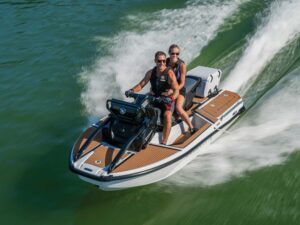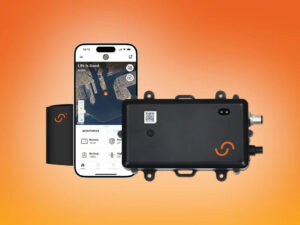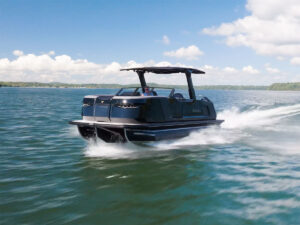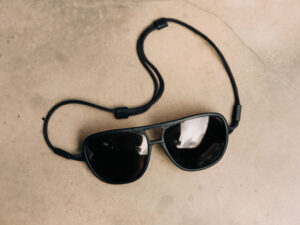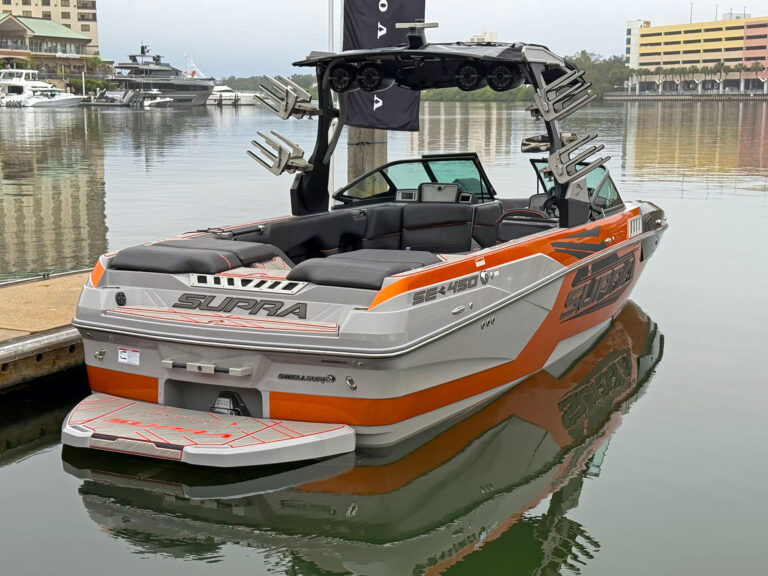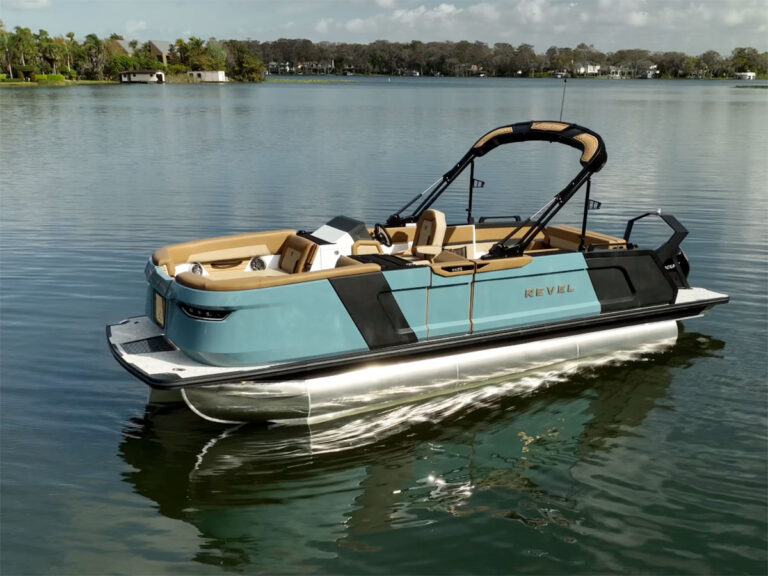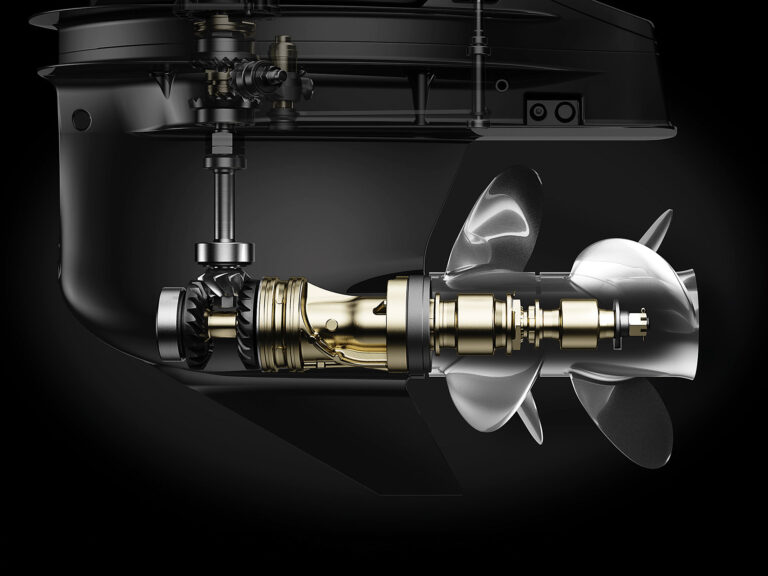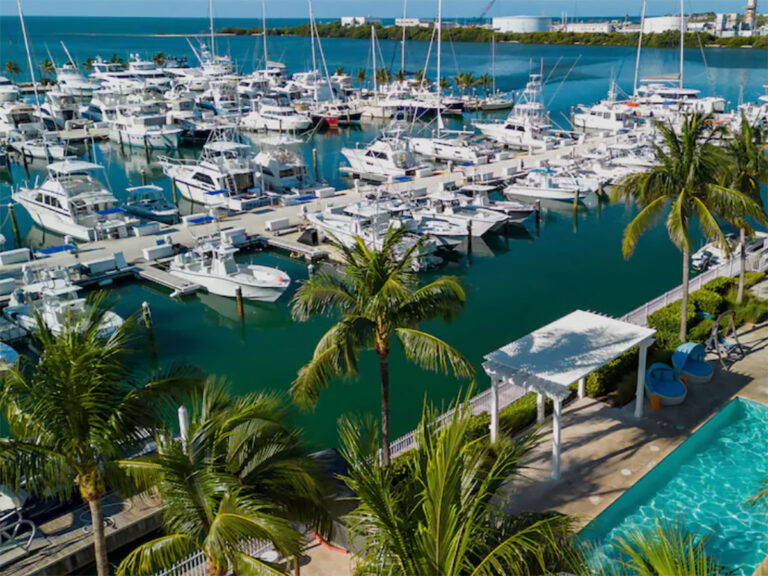
Honda took boaters by surprise this past fall when it suddenly unveiled its biggest outboard to date: a 350 hp V-8, besting its previous flagship motor by 100 ponies. While some believed Honda would forever stand pat with a 250 at the top of its line, the vacuum left in the market when Yamaha discontinued its 350 V-8 was too much to resist. Honda, along with Mercury and Suzuki, has stepped up to help fill the void.
We had a chance to test the sleek new BF350 on a couple of boats, including a twin-powered SeaVee 322Z in the waters off Tampa, Florida, and a single-engine Tahoe pontoon. But before we get to the results, let’s look more closely at the engineering behind the BF350.
Under the one-piece cowling, the Honda BF350 features a newly developed 5-liter-displacement block with a fully balanced, 60-degree offset crankshaft, built using the same alloy and strength specifications as the engine in the Acura NSX high-performance supercar, according to Honda. This eliminates the need for counterbalancing the crankshaft and seamlessly integrates with the 60-degree V-8 powerhead design to minimize engine vibration and noise.

Available in silver or white paint schemes, the Honda delivers its 350 prop-shaft horsepower using 86-octane gasoline (versus premium unleaded octane) at 5,500 rpm. The single-overhead-camshaft (one for each cylinder bank), 32-valve system incorporates Honda’s Variable Valve Timing & Lift Electronic Control (VTEC), which uses a mild cam profile to operate intake valves at low rpm but engages a higheroutput cam profile as revs increase. This results in a broader, flatter torque curve and the delivery of smooth power throughout the engine’s operating range.
In addition, Honda’s Boosted Low Speed Torque (BLAST) system advances ignition timing during hard acceleration as the ECM increases injector timing, creating a more powerful air-fuel mixture to boost torque and enhance hole shot.
The new V-8 also features Honda’s Lean Burn Control technology that automatically adjusts the air-fuel mixture according to speed and load to optimize fuel efficiency while cruising between 2,000 and 4,500 rpm. Also enhancing fuel efficiency is the new Friction Reduction technology that includes plateau honing on the engine’s cylinder bores and ion plating on the piston rings.
Honda has incorporated the Intelligent Shift & Throttle (iST) command and control system into the BF350, which allows for plug-and-play installation of Honda Marine products, and third-party controls and devices such as Dometic’s Optimus 360 joystick low-speed steering system. Fingertip ease of the electronic throttle and shift functions is made possible by a new binnacle with five buttons for trim support, automatic tilt, cruise control and trolling mode. The binnacle integrates with a new HD-5 multifunction gauge, which has menu options to view engine parameters, set auto trim limits, monitor cruise-control settings, and view engine-fault notifications.
The alternator charging system delivers 70 amps at idle and a max of 93 amps at higher rpm to help replenish batteries and power onboard electrical systems. The BF350 boasts NMEA 2000 certification to interface with a wide variety of third-party marine electronics without the need for gateway devices, simplifying repower.

Big outboards always call for weight comparisons. At 765 pounds for the 25-inch-shaft model, the BF350 is no lightweight. It’s 38 pounds heavier than the Suzuki 350 V-6 (727 pounds) and 70 pounds heavier than Mercury’s 350 V-10 (695 pounds). However, it is 39 pounds lighter than the defunct Yamaha 350 V-8 (804 pounds).
I am happy to report that my test of twin BF350s on the SeaVee 322Z was flawless. One of the big takeaways: The motor runs remarkably smooth and comparatively quiet, both to my ears and on the decibel meter, registering just 63 dB(A) at idle, 92 dB(A) at optimal cruise, and 98 dB(A) at wide-open throttle. With four crew and 156 gallons of fuel on board, the 6,900-pound (without power) SeaVee climbed on plane in 5 seconds, reaching 30 mph in 10 seconds. The double-step hull topped out at 63 mph at 6,250 rpm.
Though the BF350 does not offer built-in steering, integrating the Optimus 360 system (featured on our test boat) resulted in easy handling at speed and intuitive docking with the joystick control at the helm.
Ultimately, it’s good to see Honda step up in the outboard market and help meet the demand for an increasingly important horsepower category for new boats and the repower market. A five-year, nondeclining factory warranty will certainly help close some sales. If your outboard plans call for one or more 350 hp engines in 2024, the new Honda V-8 will be hard to ignore.

